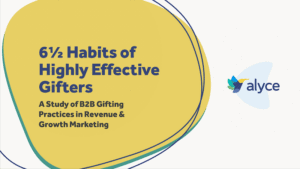
This blog post is the sixth in Alyce’s seven-part series on account-based marketing best practices. For this post on ABM budgets, we connected with accomplished ABM rock star Brian Kardon, who is CMO at Alyce client Fuze.
Sometimes we encounter new – or new-to-us – things that make us say, “How did I ever live without this?” Maybe you grew up without air conditioning and wonder how you survived your childhood summers. Maybe you remember taking your first driving test without a back-up camera and question whether you could pass the exam without it today. Maybe you discovered a new favorite cuisine as an adult and feel like you never understood what flavor meant until now.
When a B2B marketer’s path leads him or her to account-based marketing, the reaction is much the same.
Converting to the Religion of ABM
“I had never led a formal ABM strategy until a few years ago, but now ABM has become the centerpiece of our sales and marketing strategy,” says Brian Kardon, chief marketing officer at cloud-based communications company Fuze. “It has become our religion. In fact, I don’t think I could ever join a company again if it didn’t have an ABM program.”
Brian’s “How did I ever live without this?” response to ABM is a testament to the effectiveness of ABM as a strategy, and also to how Brian and the team at Fuze have put their commitment to the ABM approach into action.
When Brian joined Fuze, the company’s sales approach was fairly unfocused. Every industry and every region were fair game. “As an organization, we wanted to get smarter about where we invest our dollars,” says Brian. “I brought a handful of key opinion-makers together – a board member, our global head of sales, our head of North American and European sales, and our CEO – to talk about ABM as an approach. I showed them examples of other companies who had been using this strategy effectively and presented numbers that showed we could apply our dollars much more efficiently if we embraced ABM.”
From there, that key executive team was converted, and the company was on its way to aligning around and investing in ABM in a whole new way.
Aligning for Greatness
“We began our ABM journey by working together with Fuze’s global head of sales to build our target accounts list,” explains Brian. “It takes collaboration to get this right.”
What Brian did in the early days was develop two “tracks” of thinking: one anecdotal track built from roundtables and discussions with sales people on what they feel works well, and one data-driven track outlining attributes of accounts most likely to close. “If we were going to be all-in with ABM, our target accounts list was the most important thing to get right. We had some instances where someone thought a particular industry was great for us, but the data showed us something else. From there, we ended up with 30,000 target accounts, and 8,000 of those are assigned to sales people.”
Putting Your Money Where Your Accounts Are
“We know that our target accounts aren’t in market looking to replace their system every year. We know our target accounts are in a seven-year cycle, so we need to know when a potential customer is in market looking,” he says. “If we miss that window, we could lose our chance for the next seven years.”
With a cicada-esque customer buying cycle, the stakes are high for Fuze’s sales and marketing teams, and they apply their budget accordingly.
“In our ABM strategy, we’re willing to pay a lot to get the right meeting,” says Brian. “Our typical three-year TCV is $750,000, so it’s worth it to us to invest several thousand dollars to get a face-to-face meeting with our economic buyers and champions.”
“In our ABM strategy, we’re willing to pay a lot to get the right meeting.”
Tailoring Special Experiences
In Fuze’s ABM strategy, there is no one-size-fits-all approach to engaging target accounts. Each region has its own characteristics, and each buyer has his or her own preferences. So, Fuze invests in tailoring unique experiences to stand out and engage decision-makers.
“Before we went all-in with ABM, our spend was roughly 55% people and 45% programmatic. With ABM, that has shifted to be closer to 45% people and 55% programmatic,” explains Brian. “We are investing in more high-touch selling.”
And the programs Fuze invests in focus on giving potential buyers what Brian calls “the unobtainable” – special, tailored experiences that are thoughtful, impressive and unique.
“We spend money to give our target accounts something special. We use Alyce to send high-end direct mail to get meetings and engage people across a large buying committee. We also create special field events that are tailored to our target accounts and buyers in each of our 11 regions. Think: driving Teslas on a test track in Germany or hosting a meet-and-greet with a renowned winemaker to offer a first taste of a new small-batch release,” Brian says.
When your organization becomes an ABM convert, it is critical to build alignment, not only between sales and marketing teams, but also between your budget and how you’re spending it. In Fuze’s case, investing in high-end experiential tactics for target accounts is paying off with more of the right kinds of meetings – and the right kinds of deals.
The Moral of the Story
- Once you become an ABM marketer, you never go back
- It’s critical to get your target list right – and the accounts you put on that list should come from a mix of anecdotal information and data
- If winning a target account means a high-value contract, you should be willing to spend some money to get the right meeting and invest in the engagement
- Budget for tailored, “unobtainable” moments and experiences to stand out with key accounts
Many thanks to ABM expert and Alyce client Brian Kardon for his insights.
Have your own ideas to add?
Comment below or drop the Alyce team a line to chat.






